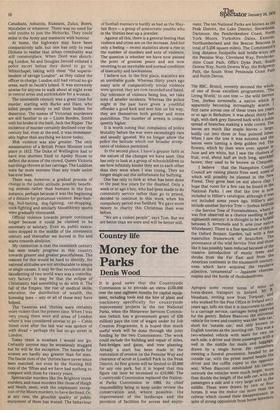Country life
Money for the Parks
Denis Wood
It is good news that the Countryside Commission is to provide an extra £150,000 over the next eighteen months for capital equipment, including tools and the hire of plant and machinery specifically for countryside improvement projects in the ten National Parks, when the Manpower Services Commission (which has a government grant of £30 million) pays the cost of wages under its Job Creation Programme. It is hoped that much useful work will be done through the joint funding by the two Commissions. The work could include the building and repair of stiles, foot-bridges and gates, and tree planting. Already a start has been made in the restoration of erosion on the Pennine Way and clearance of scrub at Losehill Park in the Peak District. At first grants will be limited to £5,000 for any one park, but it is hoped that this figure can later be increased to £10,000. The Countryside Commission replaced the National Parks Commission in 1968, its chief responsibility being to keep under review the conservation and, where possible, the improvement of the landscape and the provision of facilities for access and enjoy
ment. The ten National Parks are known as the Peak District, the Lake District, Snowdonia, Dartmoor, the Pembrokeshire Coast, North York Moors, Yorkshire Dales, Exmoor, Northumberland and the Brecon Beacons (a total of 5,256 square miles). The Commission s long distance footpaths and bridle-ways are the Pennine Way, Cleveland Way, Pembrokeshire Coast Path, Offa's Dyke Path, South Downs Way, North Downs Way, the Ridgeway
path Path, the South West Peninsula Coast and North Devon.
The BBC, Bristol, recently devoted the whole of one of those excellent programmes, 'The Living World,' to one tree — the wild Service Tree, Sorbus torminalis, a native which is apparently becoming increasingly scarce. I first came across one of these trees ten years or so ago in Berkshire; it was about thirty feet high, with dark grey fissured bark with a noble spread of branches making a wide crown. The leaves are much like maple leaves — large' boldly cut into three or four pointed lobes. When I saw the tree it was autumn and the leaves were turning a deep golden red. The flowers, which by then were over, appear in June and are white, but I saw the clusters a fruit, oval, about half an inch long, speckled brown; they used to be known as Chequers'
I believe that the Hampshire CountY
Council are raising plants from seed, some of which will possibly be planted in the New Forest. They grow best on soil above claY. hope that room for a few can be found in the National Parks. I see that the tree is hoW included in Hillier's catalogue, although it was not included some years ago. Hillier's als,e include another Service Tree — Sorbus tatifoh — the Service Tree of Fontainebleau, where it was first observed as a chance seedling in the, eighteenth century; it is thought to be a hyra between S. tormina/is and S. aria (our natty! Whitebeam). There is a fine specimen of this in the Oxford Botanic Garden, tall with a fine masculine framework of branches. The provenance of the wild Service Tree and those like it has possibly been reduced because of the, massive introduction of exotic trees aria shrubs from the Far East and from the American continent in the nineteenth centup',
isive
trees which have acquired the rept.' adjective, 'ornamental' — Japanese cherries, maples and the horde of rhododendrons. Apropos some recent notes of mine on horse-drawn transport in Ireland, Mr Measharn, writing now from Torquay, and who worked for the Post Office in Ireland sixtY years ago, tells me that it is inaccurate to refer to a carriage service, carriages being
reserved
for the gentry. Before Bianconi the universal, vehicle for town and country was the 'side car,' short for 'outside car,' and only known to English tourists as the jaunting car. This vvas a two-wheeled vehicle with seats for two on each side, a driver and three passengers with a well in the middle for mails and luggage' drawn by a single horse. He rem
meeting a funeral procession, headed by an outside car, with the priest seated beside the pposite driver and the coffin roped to the o seat. When Bianconi established his carrier network the vehicles were much larger,. more embers
than double the length of the side car, with six passengers a side and a very large middle. These were drawn by two or four horses. It was the motor car more than the railway which caused their disappearance, in spite of strong opposition from horse breeders.
well in the


































 Previous page
Previous page